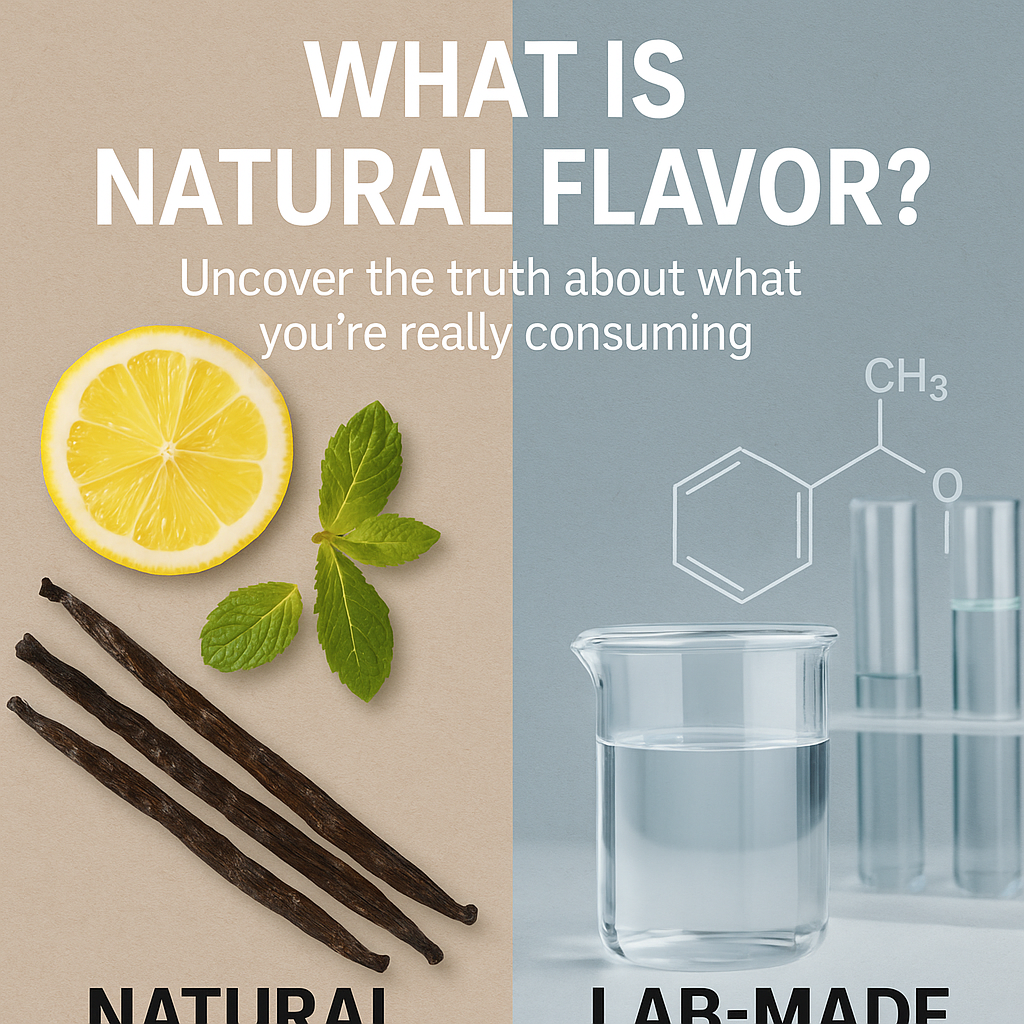🌿 What Is Natural Flavor? The Truth About the Term, the Comparison with Artificial Flavors, and Hidden Health Risks
🧭 Introduction: A Natural Illusion?
“Natural flavor” — it sounds healthy, clean, and trustworthy. But what does it actually mean?
This vague term appears on countless ingredient lists, from sparkling waters to granola bars, yet most consumers have no idea what’s behind it. In this article, we’ll demystify natural flavor, compare it with artificial flavoring, explore potential health concerns, and help you make more informed decisions about what goes into your food.
🍊 1. What Is a Natural Flavor?
According to the U.S. Food and Drug Administration (FDA), a natural flavor is any flavoring substance derived from plant or animal sources, including fruits, vegetables, herbs, spices, meat, seafood, dairy, or fermentation. It must be processed using physical, enzymatic, or microbial means to extract or refine flavor.
However, the term “natural” in this context doesn’t necessarily mean the product is:
- Unprocessed
- Additive-free
- Better for health
In fact, the final flavoring compound may have gone through extensive chemical modification, and may include solvents, preservatives, or carriers not listed on the packaging.
Common Sources of Natural Flavors:
| Type | Example Ingredients |
|---|---|
| Plant-based | Citrus peel, vanilla bean, mint |
| Animal-based | Beef extract, dairy-derived flavor molecules |
| Microbial | Fermentation-derived vanillin from rice bran |
⚖️ 2. Natural vs Artificial Flavors: What’s the Real Difference?
The core distinction lies not in the chemical structure, but in the source of the ingredients:
| 属性 | Natural Flavors | Artificial Flavors |
|---|---|---|
| 资料来源 | Derived from real plant or animal materials | Synthesized from non-natural sources |
| Molecular Identity | Often identical to natural compounds | Can also be identical |
| Label Transparency | Often vague (“natural flavors”) | Clearly labeled (“artificial flavors”) |
| Manufacturing Process | Can include chemical treatment | Synthesized in labs |
| Cost & Stability | Expensive, may vary by harvest | Cheap, highly stable |
| Sustainability Impact | Risk of overharvesting natural sources | More controlled and scalable |
Fun Fact: Most “vanilla flavor” in processed foods is made from 合成香兰素 — even if it’s labeled “natural” due to fermentation-based extraction.
⚠️ 3. Are Natural Flavors Actually Healthy?
Many consumers assume “natural” equals healthy — but natural flavors can carry hidden risks.
❗ Health Concerns:
- Ingredient Opacity: Manufacturers aren’t required to disclose the actual substances used to create “natural flavors.” You don’t know exactly what you’re consuming.
- Allergenic Potential: Natural flavors can contain milk, soy, gluten, or other allergens — but these may not be clearly labeled.
- Vegan & Halal Concerns: “Natural” flavorings can be animal-derived, making them unsuitable for vegetarians, vegans, or religious dietary laws.
- Overconsumption Risk: Flavorings can enhance palatability, potentially encouraging overconsumption of ultra-processed foods.
📊 Relevant Statistic:
A 2020 report by Environmental Health Perspectives found that over 80% of packaged foods in the U.S. contain either natural or artificial flavors — yet less than 20% disclose full ingredient origins.
🏷️ 4. Labeling & Regulatory Loopholes
Under FDA rules, companies can list complex mixtures of flavor compounds simply as “natural flavors” — even if those mixtures include dozens of ingredients, some of which may not be widely recognized or safe in large quantities.
U.S. vs EU Labeling:
| Region | Rules on “Natural Flavor” |
|---|---|
| USA | Broad definition; full composition disclosure not required |
| EU (EFSA) | Stricter guidelines; some transparency requirements on origin and treatment |
This regulatory gray area creates confusion, often allowing “natural” to become a marketing tool rather than a guarantee of purity or safety.
✅ 5. How to Choose: Smart Tips for Consumers and Brands
For Consumers:
- 🕵️♂️ Read beyond the label — look for brands that disclose full ingredient lists or flavor origins.
- 🌱 Prefer whole foods — natural flavors are often found in ultra-processed products.
- ❌ Avoid vague claims like “natural flavors” in isolation without source explanation.
- 📲 Use barcode scanners or food transparency apps to learn more about ingredients.
For Manufacturers:
- 📦 Consider using “clean label” alternatives with fully traceable components.
- 🔍 Work with flavor houses that provide allergen-free, vegan-certified options.
- 🛡️ Communicate clearly with consumers to build brand trust.
📌 Conclusion: Natural Doesn’t Always Mean Better
“Natural flavor” is a legal — but often misleading — term. While it may originate from a plant or animal, the end product is often far from what most would consider “natural.”
By understanding the differences between natural and artificial flavors, recognizing the health implications, and demanding greater transparency, consumers and brands alike can make smarter, safer, and more ethical choices.
